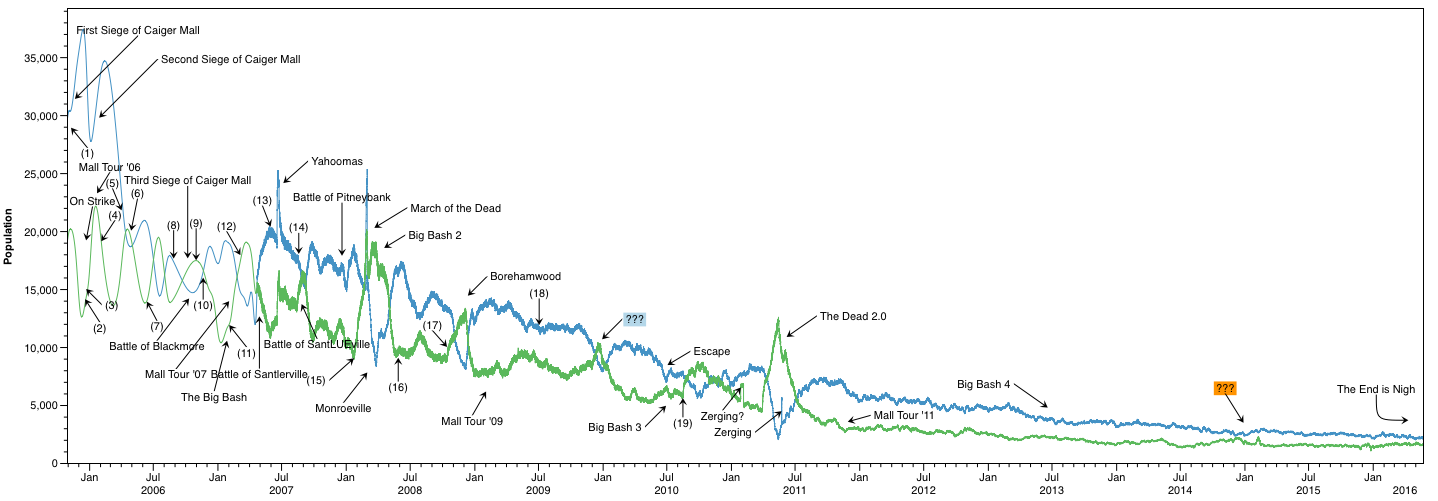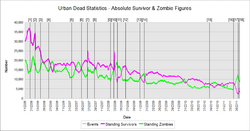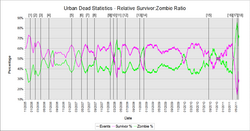User:A Helpful Little Gnome/SandboxSZI
| Contents |
| Interpreting the Graph • The Future and Conclusions • Gallery and Further Reading |
| Survivor (blue) and zombie (green) populations from October 2005 to December 2013. Dips and peaks correspond to notable player events (names) and game updates (numbers). Scroll horizontally to view full graph. |
Interpreting the Graph
The graph shows that significant player events and game updates correspond to peaks and dips in the survivor and zombie populations. It is assumed that the ratio will not change without the effects of game updates and player events. When these occur, the ratio changes if not reversing to favour the other side. After that, and as the norm, the ratio tends to favour survivors. As game updates and events become less prevalent, the ratio settles. Since August 2011, the ratio has refused switch, and rests unfettered at 2:1 in favour of survivors. Ideally, players prefer one of three of the following ideal ratios.
- Equal numbers of zombies and survivors. Rarely stated explicitly, implied by the word "balance", this viewpoint holds that Malton's population should be split 50:50 between living and unliving. Members of both sides could easily find opponents. Often, people think that if one side numbers fewer than 50%, then it must have an inherent weakness, and so needs to be made more powerful. Game updates are often implemented to correct an uneven balance, but generally seem to only have a short term effect.
- Zombies heavily outnumber survivors. Considered to be particularly in-genre, here humans desperately try to survive against vastly larger numbers of zombies. The risk (or is that the opportunity?) here is that the zombies may wipe out the last of the survivors, and without survivors to play with or against, the game is over.
- Let it be (Laissez-faire). This view says it's best that search and barricade rates are not adjusted, and that game mechanics are not changed to alter the ratio. Zombies are simply better than survivors as far as long-term combat and staying power goes, yet survivors almost always have the numbers advantage. This means that advantages given to zombies would increase the power of an already superior class, while advantages given to survivors only solidifies their strength in numbers. Leaving things as-is means that every event in-game is a result of player actions.
The ratio refuses to rest at a 50:50 split. Equal numbers usually only happens when the ratio switches. The longest interval at that ratio is only a month long—from November to December 2010. When zombies heavily outnumber survivors, the effect is short-lived and hinges on game updates or events (e.g. the Dead and events 2, 3, 15). For the past few years, the game has been left to its own devices. Without updates or large events, survivors are given the numbers advantage.
Why is the ratio so?
Factors Influencing the Ratio
People will play the side they want to play. There is little to stop a player from playing the game as a survivor or zombie; it just matters what the player finds fun. This being so, players choose a side for many reasons. THIS IS A GOOD PLACE TO ADD INPUT. THIS SHOULD BE AS FACTUAL AS POSSIBLE.
- Game mechanics. This includes many things, for instance:
- Differences exist in AP required to perform complementary actions between survivors and zombies. It takes more AP to remove barricades than to build them, as is often cited. Zombie melee is more AP efficient than survivor melee (further details).
- Perceptions of game balance affect interest (i.e. a player may view their side as being underpowered).
- Survivors play differently than zombies. Survivor gameplay is more complex; they have a greater diversity of actions. Many survivor actions have no complement on the zombie side of things. For instance, survivors can search, speak better and use radios, and have more ways to kill. Zombie gameplay revolves around breaking barricades and killing survivors, mostly using the same button—the claw.
- It is takes less for zombies to get back into play than for survivors. Apart from Combat Revives, killing a zombie does not cause it to "switch sides" and become a survivor; only AP is required for the zombie to play as a zombie again. Upon death, survivors must rely on other players in order to play as a survivor again. The point? When times are tough for survivors, a few things happen. Survivors stay as zombies longer, since many revivers are dead themselves and those who live may be AP-strapped. At this point AP is idle while these survivor "Mrh? Cows" sway at revive points. Thus zombie numbers are "artificially" larger (meaning fewer zombies are hunting survivors than would otherwise be thought); and survivor are less able to recuperate their numbers when they need the revives the most. (The net affect of this, or how much ratio is pulled toward zombies and how much to survivors, is debatable.)
- Game updates. Changes made by Kevan correlate with changes in the ratio, sometimes ending up with zombies favoured, but at other times, survivors are. Usually this is short-lived, but it might be interpreted that the ratio was permanently brought closer together after updates 1 through 5 were added.
- Player events. Outside groups inject many players into the game, who many prefer to play as one side over another. Yahoomas and the Dead are examples.
- Survivors are the good guys. Or, similarly, people often play zombie apocalypse games to fight zombies and survive.
- Survivors have a significant sub-set, PKers; zombies don't. A notable portion of the survivor population are PKers. Conversely, ZKers aren't so popular. (How significant?)
- Severely unbalanced ratios are self-correcting. Syringe search rates become higher with fewer survivors relative to zombies, and vice versa. Players might also leave out of boredom or frustration, when the ratio is large. For instance, when there are many zombies, it is more difficult to find survivors to eat. This is boring and frustrating and zombies might leave or convert to survivors. Thus ratios more extreme than 2:1 are difficult to maintain. It might be expected that a 50:50 ratio would be the easiest to maintain, yet this ratio is rare.
The Future and Conclusions
Urban Dead will probably continue to suffer the slow, stable decline characteristic of the population trend of the last few years. Game updates are non-existent and events rare, and those events that occurred are lost in the day-to-day variations in populations. Zombies have received the lion's share of buffs and updates, yet their numbers are normally lower than survivors. How much the ratio is due to difference in game mechanics for survivors and zombies and how much a result of player preference is unclear. The ratio will likely remain 2:1 in favour of survivors, unless new game updates produce long-lasting population changes and/or players decide to play the game differently.
((This section could have more to say))
Gallery
September 2005 to April 2009. A Brief History Of Barhah compares population statistics with a timeline of sieges and zombie campaigns.
See Also
- Game Balance (out of date)
- Equilibrium (out of date)
- Game Timeline (pre-2013)
- See Ratio History for descriptions of notable ratio changes. Mostly pre-2010.
External Links
- Game Statistics Page
- Game Statistics Log for comprehensive data post April 22, 2007
- Wayback Machine for sporadic data pre April 22, 2007



